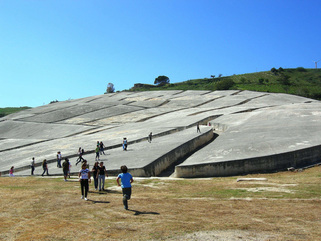Strange Places in Italy: The Cretto de Gibellina, A Concrete Colossus Artwork Covering a Ghost Town2/26/2016  Ever since the Greeks and Romans ruled Italy, they have built monuments that have lasted for several millennia--many using concrete. Concrete type materials were used by humans for over 6500 years in Syria and Jordan. Hydraulic lime with cementing qualities were in use by 700BC. The ancient Romans discovered that adding volcanic ash to the mix allowed it to set underwater. In Rome, the huge domed ceiling of the Pantheon is made entirely of unsupported concrete. Romans added hair to prevent cracking and blood to make it frost resistant (hopefully, not human!) It should be no surprise that Italians are still using concrete, often in unusual ways... One example of this can be see from space on Google Earth: The Cretto de Gibellina (the Crack of Gibellina) in central Sicily. Also known as Cretto di Burri (Crack of Burri), named after Alberto Burri, the artist who created it, it is a half mile square work in concrete which resembles the cracking that appears in dried river mud. It was installed at the original site of Gibellina, a village that was completely destroyed by a 1968 earthquake. It looks as if the artist meant the cracks to represent the cracks in the earth and the lives of the people of Gibellina. In actuality, Burri covered the actual footprint of the buildings in the original town, while leaving the streets as pathways throughout the concrete. (The town of Gibbellina was relocated and christened Nuova Gibellina 20 kilometers away.) Being truly a monument to the town and the 1150 lives that were lost, the concrete installation actually contains the building rubble including furniture, utensils, and toys. Walking the "streets" visitors feel the emotions of the loss.  This unusual piece of modern art is worth the visit, as are many so-called ghost towns throughout Italy that have been abandoned after being destroyed by earthquakes. There are often recitals, other artists' installations, dance performances as well as the ruins of village buildings painted by other artists. It's like walking into a futuristic, post-apocalyptic film like Mad Max. The work was left unfinished after Burri ran out of funds in 1989, but in 2015, to honor what would have been Burri's 100th birthday, funding was found and his work was completed... made obvious by the much whiter colored concrete in one corner of the site.
2 Comments
Pavel Bouse
3/1/2018 06:17:44 pm
Dear Jerry,
Reply
Jerry Finzi
3/1/2018 11:09:40 pm
This image was gotten from Google Image search. There was no copyright information on it. I just finished another image search using date ranges going back 18 years and could not find the original use of the image, nor a photo credit or copyright. Sorry I cannot help you. Use it if you wish, otherwise, there are many other images with photo credits of the Cretto that you might be able to track down permissions.
Reply
Your comment will be posted after it is approved.
Leave a Reply. |
Categories
All
Archive
June 2024
|








 RSS Feed
RSS Feed
